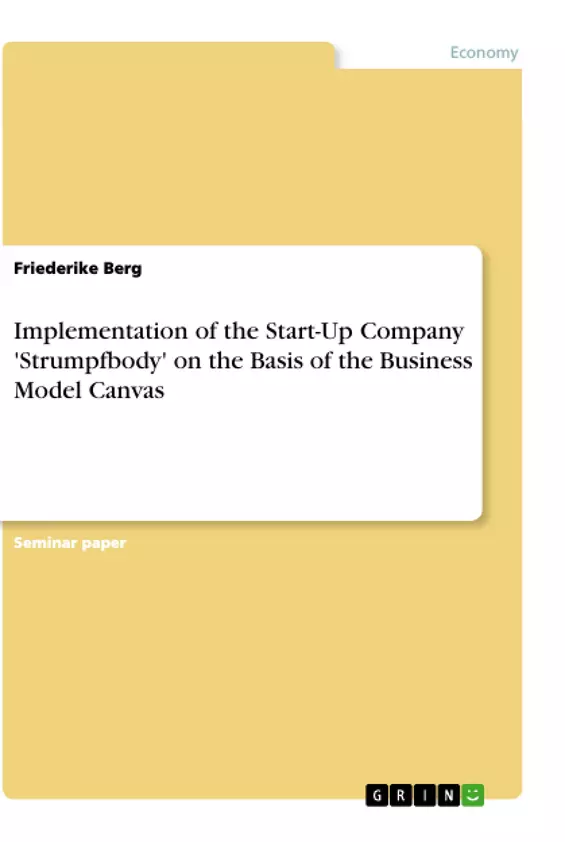This paper shows the implementation of the business model Canvas with reference to a specific example. It describes how we came up with the idea of the new start-up company which, is called "Strumpfbody".
In the 19th-century machine-made cotton stockings became available for women. After World War I (1914-1918) short skirts were fashionable and long silk stockings were worn again. With the discovery and ultimate use of Dupont Nylon in the late '30s and early '40s, the primacy of silk in women's hosiery waned. Silk was ultimately replaced by nylon after the war. Nylon stockings which became popular after World War II (1939-1945) and completely replaced the silk stocking usually had seams until the late 1960s. They were knitted flat and "fully fashioned" which means that they were shaped to fit the leg like modern sweaters. By decreasing the number of stitches as the stocking was knit towards the ankle, a garment was created that was "knit to fit". By the early sixties, "fully fashioned" or seamed stockings were rapidly replaced by the modern reinforced heel and toe seamless stockings.
In the 1960s when skirts were worn very short, many women began to wear tights (pantyhose) instead of stockings. To show, "a bit of stocking", was no longer accepted and while stockings fought for market share by becoming extremely long, they became nearly extinct as pantyhose gained in popularity. "For much of the 20th century, pantyhose were an essential component of any polished woman’s outfit. But then, many Gen X and Boomers stopped wearing pantyhose years ago, dismissing them as uncomfortable and easily ruined by runs. Most Millennial women have never even worn them, and thanks to more casual office wear, they don’t need to in most offices." The majority of the leading brands of pantyhose and nylons in the United States have to struggle with this development. Therefore the market needs a new innovation, which will be described in the following paper.
Inhaltsverzeichnis (Table of Contents)
- Role of the Hosiery in the Textile Industry
- Economic and Innovative Potential of the Hosiery Industry
- Structure of the Seminar Paper
- Theoretical Basis
- Introduction to the Textile Start-Up Business
- Definition and Origin of Start-Ups in the Textile Industry
- Start-Up Companies and their Characteristics
- Conception of the Business Model Canvas
- Definition and Comparison of Business Models
- Nine Segments of Canvas
- Introduction to the Textile Start-Up Business
- Implementation of the Business Model Canvas with an specific Example
- Development of the Fashion Start-Up ‘Strumpfbody’
- Conception of the Product
- ‘Strumpfbody’ on the Basis of the Business Model Canvas
- Review
Zielsetzung und Themenschwerpunkte (Objectives and Key Themes)
This seminar paper examines the implementation of a start-up company, 'Strumpfbody', in the textile industry, utilizing the Business Model Canvas. It explores the economic potential and innovative nature of the hosiery industry, focusing on the development of a unique product within this sector.
- Economic and Innovative Potential of the Hosiery Industry
- Start-Up Business Models in the Textile Sector
- Application of the Business Model Canvas
- Development and Implementation of a Fashion Start-Up
- Analysis and Evaluation of 'Strumpfbody' using the Business Model Canvas
Zusammenfassung der Kapitel (Chapter Summaries)
- Chapter 1: This chapter examines the role of hosiery within the textile industry, focusing on the economic and innovative potential of this sector. It provides an overview of the current market trends and highlights the potential for growth and innovation in the hosiery industry.
- Chapter 2: This chapter establishes the theoretical foundation for the seminar paper. It delves into the concept of start-up businesses within the textile industry, examining their definition, characteristics, and origin. It also introduces the Business Model Canvas as a framework for conceptualizing and implementing business models.
- Chapter 3: This chapter presents a detailed application of the Business Model Canvas to the development of 'Strumpfbody', a fashion start-up. It explores the development of the product concept, its key features, and its position within the market. It then analyzes 'Strumpfbody' using the Business Model Canvas, examining its customer segments, value propositions, channels, customer relationships, revenue streams, key resources, key activities, key partnerships, and cost structure.
- Chapter 4: This chapter provides a review of the project, offering critical reflection on the implementation process and the potential for future development.
Schlüsselwörter (Keywords)
This seminar paper focuses on the key terms and concepts related to the textile industry, start-up businesses, the Business Model Canvas, and the specific case study of 'Strumpfbody'. The primary focus is on the economic potential of the hosiery industry, the application of business models in the textile sector, and the development of a unique fashion start-up.
- Quote paper
- Friederike Berg (Author), 2015, Implementation of the Start-Up Company 'Strumpfbody' on the Basis of the Business Model Canvas, Munich, GRIN Verlag, https://www.grin.com/document/505669



